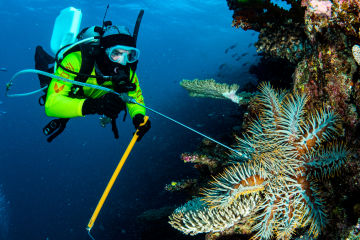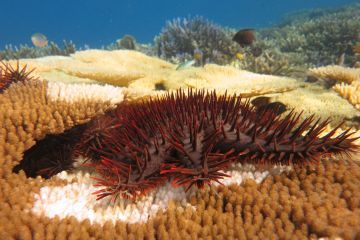COTS Control Innovation Program
A targeted research program aimed at boosting capacity to predict, detect and respond to COTS outbreaks at scale across the Great Barrier Reef.

#Delivering innovation for real-world impact.
CCIP is a collaborative research partnership between the Foundation and leading institutions with COTS expertise – AIMS, CSIRO, James Cook University and the University of Queensland. Our research directly improves the on-ground approach to coral protection by the COTS Control Program, led by the Great Barrier Reef Marine Park Authority. Every coral we save from COTS can reproduce and help repopulate damaged areas.
Find out about the impact of the program here in the Synthesis & Impact Report 2021-2024.
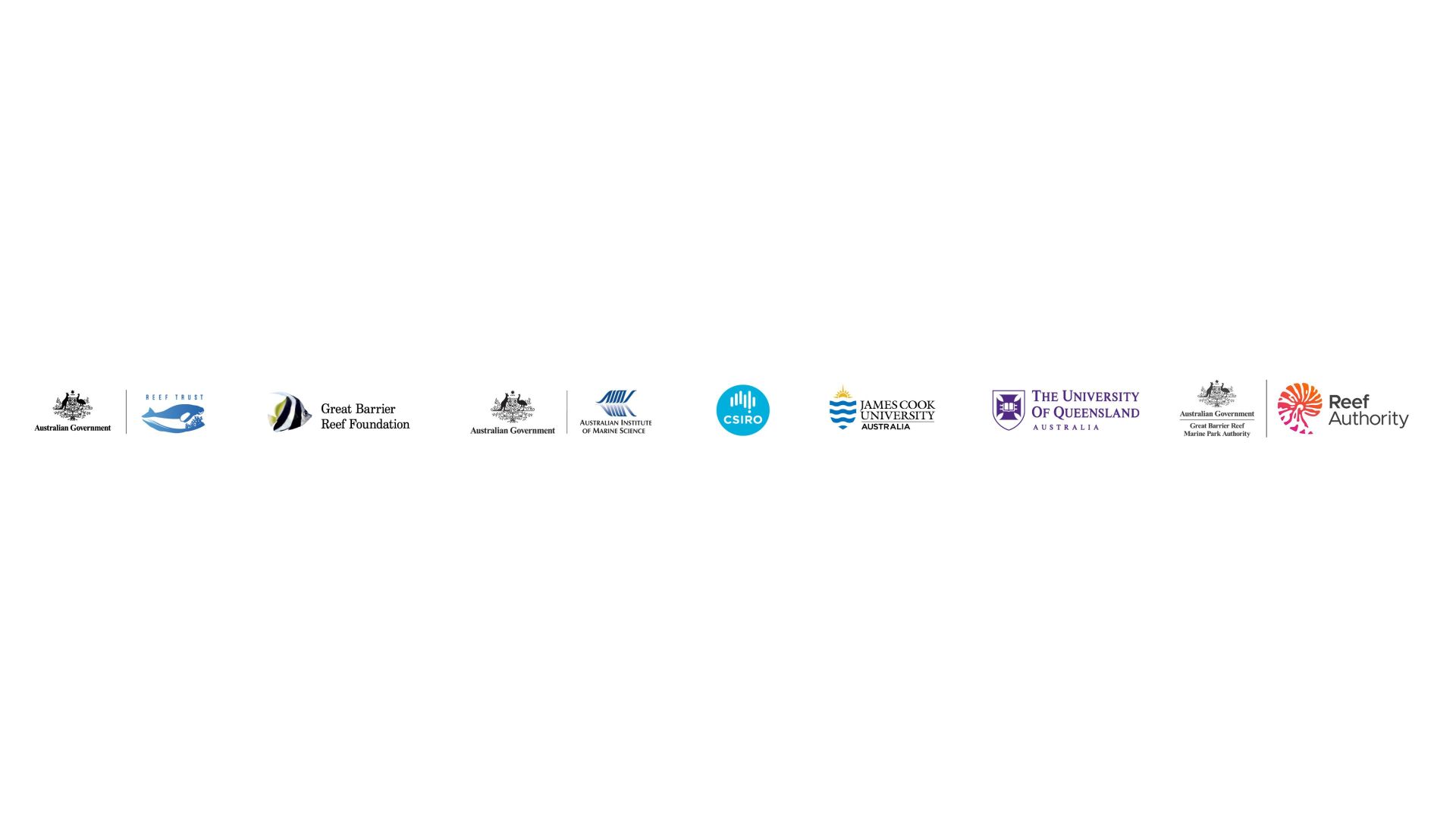
#About the Innovation Program
The innovation program brings together Australia's leading experts to collaborate on solutions to the COTS threat. It is the first of its kind, with over 90 multi-disciplinary experts working together under one program with a clear focus on delivering innovation that will drive progress in our ability to predict, detect and respond to these damaging outbreaks. The program was initially funded with $9.8m from the partnership between the Foundation and the Australian Government’s Reef Trust. Research partners co-contributed an additional $8m.
In 2020-21, the program underwent an initial design phase to prioritise the research investment. The design process engaged over 40 scientific experts and stakeholders who assessed the feasibility and benefit of a broad range of possible research investments. These experts recommended investment in a portfolio focused on research and innovation that will help us supress and prevent future outbreaks.
From 2021 to 2024, the CCIP research portfolio included 24 projects addressing key gaps in knowledge and capability across COTS biology and ecology, genetics, data science, engineering, modelling, decision science, and social science research. Program delivery was guided by a Research Impact Plan and CCIP researchers worked closely with reef managers and the COTS Control Program to ensure that innovations were fit-for-purpose for real-world application. Effective COTS control is a critical part of the toolbox of interventions the Reef needs to cope with climate change, and it complements other interventions developed under RRAP.
In June 2024, as projects across the innovation program began to wrap up, the Reef Trust Partnership secured an additional $1.7m in funding to (1) support the translation and application of CCIP research in the COTS Control Program, and (2) design a new innovation program that builds on the outcomes of CCIP.
#CCIP Research Projects
Research projects in the CCIP portfolio were organised into subprogram themes. Researchers worked with their colleagues within and across subprograms to maximise impact and ensure cross-disciplinary knowledge was widely shared.

#Early Investment Projects
Three projects were selected for early investment totalling $190k while the full portfolio was being designed. These were strategically important as they filled critical knowledge gaps, were time critical and built momentum for research to be undertaken in the R&D Phase.
Semiochemical deployment
Project team: AIMS (lead), UQ, CSIRO, USC
This project developed hydrodynamic models to understand the spatial and temporal footprint of semiochemical delivery around reefs, and, based on these, reviewed delivery strategies and systems for semiochemical biocontrol of COTS, building on applications developed for other aquatic organisms.
Initiation zone COTS surveys
Project team: JCU (lead), AIMS
The purpose of this study was to quickly embark on proposed research that explicitly tested for spatial variation in density, distribution and demography of COTS populations in different regions of the northern and far northern GBR. The urgent priority allowed detailed surveys in areas to the north of the perceived "initiation box” to be completed, testing whether there is already evidence of elevated COTS densities.
Initiation zone water quality modelling
Project team: AIMS (lead), CSIRO
This early investment project leveraged existing eReefs model outputs and water quality guidelines to conduct a small desktop study that assessed whether improvements in land management are likely to deliver water quality improvements sufficient to reduce the frequency of outbreaks of Pacific Crown-of-Thorns Starfish.
#Prediction subprogram
Through an investment of $1.62m, the six projects in the Prediction subprogram delivered new empirical knowledge of when, where and how outbreaks develop to inform early detection and response. Projects focused on COTS ecology and biology, understanding the role of predators in mitigating outbreaks, feeding rates and population dynamics.
In-situ feeding rates
Project team: JCU (lead), USYD, UTAS
This project provided highly resolved feeding rates for COTS based on extensive field-based sampling, which are critical to population modelling and decision support for effective outbreak response. The project made use of new opportunities afforded by structure from motion (SfM) photogrammetry to effectively account for the morphological variation and fine-scale complexity of different corals. Daily feeding rates varied greatly with the size of COTS and local availability of coral prey, with no apparent effect of local COTS densities. These results suggest that individual feeding rates are likely greatest during the early initiation of outbreaks.
Population collapse
Project team: JCU (lead), AIMS
This project intended to use field collections and laboratory experiments to determine causes of abrupt population decline at the end of local outbreaks. Initial collections revealed strong skews in the sex ratio of wild populations towards males, especially after the spawning season. A high-density COTS population on Banfield reef, which included unhealthy-looking individuals, was also sampled in the field. The project was terminated early due to capacity changes in the team. Future analyses could assess nutritional status, expression of genes implicated in immune and stress responses, bacterial profiles, and metabolic profiles, providing insight into the factors leading to population collapse.
Juvenile ecology and resilience
Project team: USYD (lead), SCU
This research investigated the behaviour, growth traits and biochemistry of juvenile COTS. It found that the juveniles have distinct chemosensory capabilities. They respond to olfactory information not previously encountered in their life exhibiting attraction to cues that signpost the location of their food/nursery area and the presence of live coral prey. They were deterred to cues from adults. Quantification and modelling of 8 growth traits revealed their potential application as age markers.
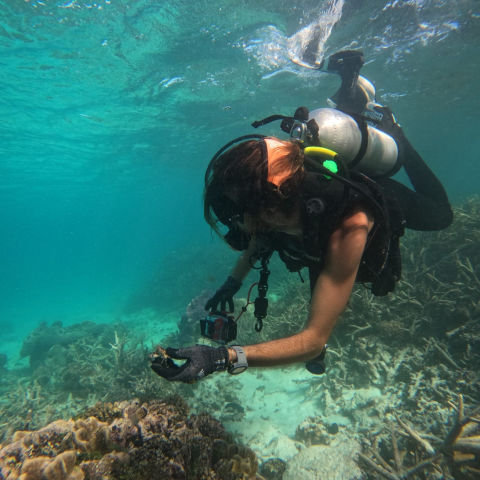
A Researcher conducting COTS field work.
Photo credit: Morane Le Nohaic
Benthic predation in rubble
Project team: UQ (lead), AIMS, SCU
This project identified 31 new predators of COTS during their juvenile, rubble-dwelling phase. The decorator crab, Schizophrys aspera, demonstrated the highest reported rate of predation on juvenile COTS. COTS DNA was detected in ~15% of wild predators, which were inversely correlated with outbreaks at reef and regional scales. This confirms these newfound predators as important bioindicators of COTS outbreaks with their consumption of juveniles potentially accumulating to have disproportionate impacts on COTS population success.
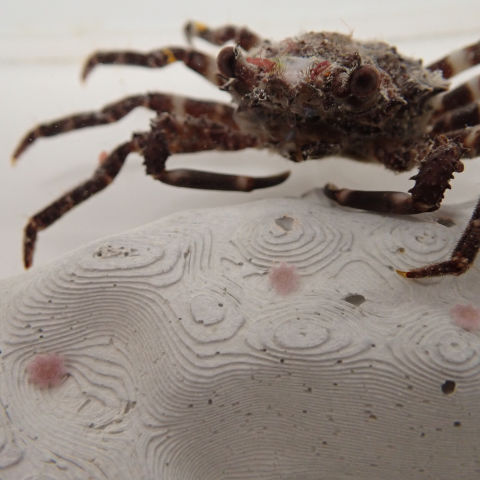
The decorator crab could be an important predator of juvenile COTS.
Photo credit: Dr. Kenny Wolfe
Fish predation rates and zoning
Project team: JCU (lead), SCU, UTAS
This project used standardised predation assays to assess differential risk of predation on adult COTS at reefs within different fisheries management zones. This research demonstrated that adult COTS are at substantially higher risk of predation at sites closed to fishing compared to sites open to fishing. The spangled emperor was identified as the foremost predator of adult COTS, highlighting a potential role for targeted fisheries management in mitigating outbreaks.
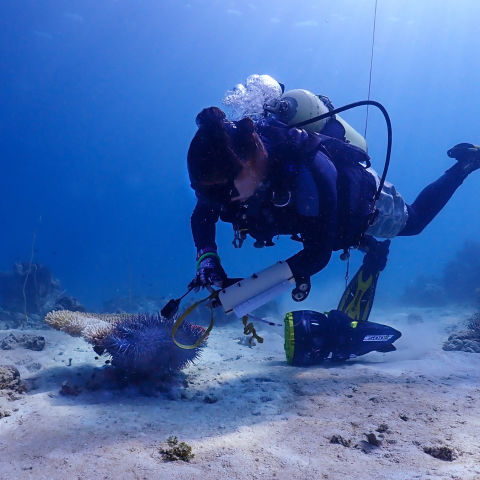
Surveys reveal COTS population dynamics.
Photo credit: Dr. Ceimon Caballes
Pre-outbreak monitoring
Project team: JCU (lead), AIMS
This project conducted extensive field surveys (using SALAD and eDNA sampling) to assess inter-annual changes in the abundance of COTS across the northern and far northern Great Barrier Reef (GBR). Elevated densities of large-sized COTS were documented in the Cape Grenville and Lizard Island regions, signifying their potential role in initiation of renewed population irruptions on the GBR. Because densities in the far north were detected prior to increases within the putative initiation box, these results challenge underlying paradigms regarding the location and cause(s) of outbreak initiation.
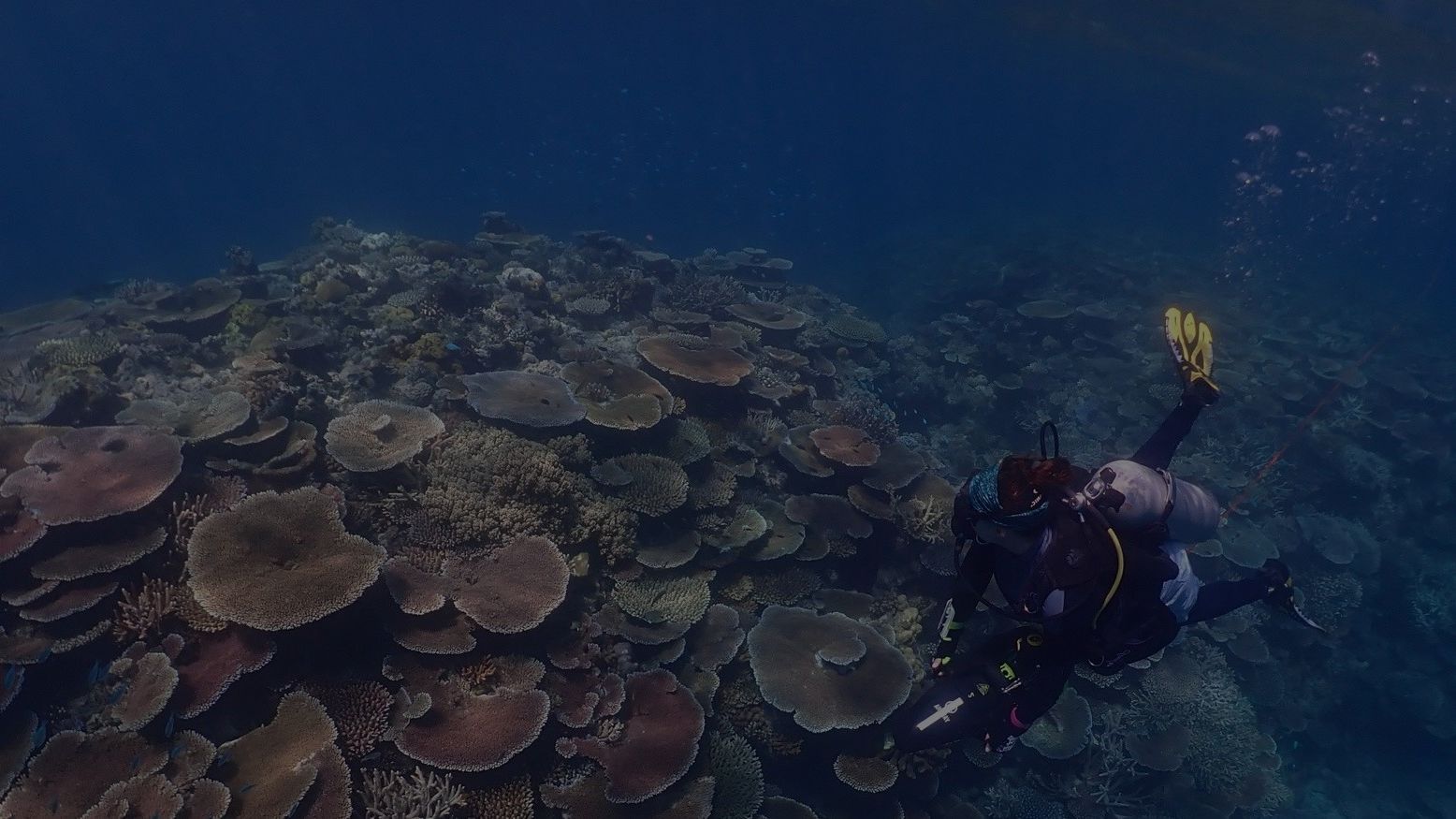
#Detection Subprogram
Through an investment of $2.47m, the four projects in the Detection subprogram developed a new suite of tools and technologies to dramatically improve the safety and efficiency of COTS monitoring and surveillance methods and provided enhanced data outputs to inform on-water response.
COTS monitoring design
Project team: CSIRO (lead), AIMS, JCU, GBRMPA
This project developed a monitoring strategy for COTS and coral that integrates information from a range of survey tools to guide decision making in the COTS Control Program. The strategy is focused on generating an unbiased, comprehensive dataset that captures both temporal and spatial variability in COTS populations, detects outbreaks early and will significantly improve the ability to evaluate Control Program effectiveness in reducing COTS numbers and protecting coral outcomes.
Tool comparison
Project team: CSIRO (lead), AIMS, JCU
This project undertook an ambitious large-scale experiment, deploying the existing and emerging COTS and coral monitoring tools side-by-side and developed statistical models to calibrate the estimates produced by each tool with each other relevant tool. These models, along with a qualitative tool comparison, will increase the ability to incorporate multiple sources of data into the decision-making process, reducing uncertainty and facilitating more informed management decisions, ultimately leading to improved coral protection.
Operationalising eDNA monitoring
Project team: AIMS (lead)
This project developed methodologies and sampling strategies to use eDNA for early detection of COTS on a reef, as part of a monitoring program. A cost benefit analysis was used to recommend a sampling design that maximises statistical power while reducing cost. Standard operating procedures were successfully trialled with on-water operators, including COTS control vessels, tourist operators and the Reef Joint Field Management Program. The eDNA techniques developed are highly versatile and can be adapted to meet a variety of operational challenges, including detection and quantification of COTS at pre outbreak densities.
The COTS Surveillance System
Project team: AIMS (lead), CSIRO
This project developed an end-to-end system for COTS and coral surveillance across the Great Barrier Reef, including a towed survey platform, machine learning models, data workflows, and user interfaces. This system intends to deliver a major step-change in the accuracy, safety, and spatial scale of COTS outbreak surveillance.
#Response Subprogram
Through an investment of $3.37m, the 11 projects in the Response subprogram delivered innovation in outbreak response models, strategies and decision support tools to improve the efficiency and effectiveness of the COTS Control Program to suppress future outbreaks. The research also added to our understanding of the cultural and socio-economic benefits of COTS control and the regulatory implications of novel control methods.
Information Infrastructure
Project team: CSIRO (lead), JCU, QUT, UQ, GBRMPA
Effective and innovative Crown-Of-Thorns Starfish (COTS) control requires information from multiple places to be collated and analysed, and the interpreted outcomes to be delivered quickly and accurately to decision makers. This project designed and implemented the COTS Information System to: 1) increase efficiency by making data sharing easier; 2) increase effectiveness by delivering research results directly to managers; and 3) multiply innovation by sharing data and methods between researchers.

Decision support tools inform pest management activities.
Photo credit: Rick Abom
Empirical Decision Support
Project team: CSIRO (lead), JCU, GBRMPA
The COTS Control Program uses data to make decisions and adaptively refine operations. This project provided four key innovations in the way data is used to improve efficiency and effectiveness: 1) automated data processing using Reusable Digital Workflows; 2) adaptive refinement of key Control Program parameters with empirical analysis; 3) research delivery using Manager Dashboards; and 4) on-water decision support using the COTS Control Centre app.
Reef-scale modelling
Project team: CSIRO (lead), UQ
This project modelled reef-scale COTS and coral dynamics to develop ecological thresholds responsive to variation in coral cover and COTS populations across reefs targeted by the COTS Control Program. Leveraging new empirical data, it evaluated management interventions and included synthesis of how management strategies may be evaluated to ensure control resources are not over-invested and effectively used under coral bleaching scenarios to achieve the best (and most robust) coral outcomes.
Regional modelling
Project team: UQ (co-lead), CSIRO (co-lead), GBRMPA
This project used two COTS-coral community models, CoCoNet and ReefMod, to identify COTS control strategies that would maximise the resilience of coral populations across the Great Barrier Reef (GBR). The study demonstrated that targeted and continuous COTS control significantly enhances coral cover and reef resilience. It also validated the effectiveness of GBR-wide control strategies and highlighted the importance of dynamic, adaptive management to optimise resource allocation and improve outcomes for coral conservation.
COTS dispersal ensemble modelling
Project team: JCU (co-lead), QUT (co-lead), UQ, UCL
The project has developed a novel approach to accounting for uncertainties at both the physical and biological level when estimating larval dispersal. By developing an ensemble of biophysical models, the project has focused on identifying and evaluating the uncertainties in each step required to estimate COTS dispersal across the Great Barrier Reef. This approach has focused on enhancing the accuracy, robustness, and applicability of dispersal predictions to support effective reef management and conservation efforts. The improved dispersal predictions are key to understand reef organism dynamics and underpin effective management strategies to preserve and restore this vital ecosystem.
Cost effectiveness of control
Project team: CSIRO (lead), UQ, GBRMPA
This project conducted an economic assessment of alternative scenarios to inform the strategic allocation of COTS Control Program resources. The project found that targeted and continuous control generates a net benefit to the Australian people (allocative efficiency), with different benefit types (e.g., non-use, tourism) maximised under different scenarios. The results further suggest that the assessed scenario which generates the most value-for-money (cost-effectiveness) depends on the chosen management objective(s).
Multi-criteria decision-making for reef prioritisation
Project team: QUT (lead), CSIRO, GBRMPA
This project developed a formal Multi-Criteria Decision Analysis (MCDA) framework to inform the prioritisation of reefs for control in the COTS Control Program. The project developed a formal method of incorporating multiple data streams, values and perspectives into prioritisation to: 1) innovate the quantity and quality of data used for prioritisation; 2) innovate the repeatability and transparency of prioritisation, and 3) to include a broader cross-section of stakeholder values.
Stakeholder perceptions and co-benefits
Project team: JCU (lead), UQ
This project has collected baseline data on sociocultural perceptions of COTS as a native species, as well as its role as a significant pest in the GBR and beliefs about the need for COTS management, from a diverse range of GBR stakeholder groups. The project also explored attitudes towards possible control scenarios (predator control and the use of semiochemicals), with a focus on stakeholder perceptions of acceptability and risk.
Reef Traditional Owner co-design and values assessment
Project team: JCU (lead), CSIRO
The project developed a co-design approach for co-production to support delivery of two place-based case studies with reef Traditional Owner research partners: (i) Ngana Muruk Junkurrjiku Janay (Standing up very strong together) Research and Management Protocol, (ii) Yadaba Darumbal Respect Protocol for Research and Management on Country. The protocols guide research and management to align with local community priorities and needs. The project also supported the training and employment of First Nation Research Assistants contributing to existing undergraduate work Integrated Learning programs and sharing information with Indigenous COTS divers and sitting members of COTS advisory committees. The project highlighted the urgent need for meaningful and respectful relationships between Traditional Owners and all reef stakeholders operating across Sea Country.
Fish predator conservation for biocontrol
Project team: AIMS (lead), CSIRO, GBRMPA
This project used CoCoNet, a regional-scale model, to assess the efficacy of fish predator conservation scenarios (e.g. zoning, fisheries management) to control COTS outbreaks along the Great Barrier Reef. Simulations corroborated the benefits of the 2004 rezoning of the Great Barrier Reef in terms of increased fish predators and coral cover, and lower COTS densities. Forecasted scenarios showed that increasing zoning and fisheries restrictions can provide substantial benefits to fish predator numbers, as well as additional biocontrol of COTS outbreaks and improvements in coral cover over the next 10-25 years. However, the effects of climate change will ultimately have a greater influence on coral cover in the longer term.
Semiochemical biocontrol
Project team: AIMS (lead), CSIRO, UQ, USC
Pheromones are naturally occurring signalling compounds that are critical for species-specific aggregations. This research established a novel pipeline for the discovery of aquatic animal semiochemicals, leading to the elucidation of adult COTS attractant pheromones. These pheromones hold exciting potential as environmentally friendly and economically efficient mechanisms for COTS control and monitoring, within an integrated pest management framework. Overall, the findings reinforce the immense potential of aquatic pheromones to overcome current and emerging problems with aquatic pests.
#Research Translation
After three years of dedicated research effort (2021-2024), CCIP has delivered over 120 outputs including new knowledge, plans, decision support tools, modelling predictions, methods and technologies. Our program is committed to ensuring this research is translated into wisdom that can be applied in COTS management to better protect coral reefs. With this goal in mind, CCIP partners have prioritised investment in eight Research Translation projects in 2025. These projects will see researchers and managers working together to apply and operationalise research findings in COTS Control Program systems and processes.
#Latest news and science highlights

People of the Reef ·
Taylah Bruce: ‘Protecting corals from COTS is empowering’

People of the Reef ·
Mary Bonin: ‘Billions of tiny plants and animals worked to build our unique Reef’

Explainers ·
What are crown-of-thorns starfish?

News ·
Less COTS, more corals
#Publications
Read the latest CCIP peer-reviewed publications:
- Bartelet, HA., Lockie S, Demeter C, Ritchie B (2025) Public support for novel crown-of-thorns starfish (Acanthaster spp.) control interventions using semiochemicals on the Great Barrier Reef, Coral Reefs. https://doi.org/10.1007/s00338-025-02773-z
Bartelet HA, Paxton G, Lockie S, Backhaus V, Brooksbank L (2025) A social license to operate theory for lethal control of crown-of-thorns starfish on the Great Barrier Reef. People and Nature. https://doi.org/10.1002/pan3.70159
Castro-Sanguino C, Bozec Y-M, Condie SA, Fletcher CS, Hock K, Roelfsema C, Westcott DA, Mumby PJ. (2023) Control efforts of crown-of-thorns starfish outbreaks to limit future coral decline across the Great Barrier Reef. Ecosphere, 14:e4580. https://doi.org/10.1002/ecs2.4580
Chandler JF, Burn D, Caballes CF, Doll PC, Kwong SL, Lang BJ, Pacey KI, Pratchett M. (2023) Increasing densities of Pacific crown-of-thorns starfish (Acanthaster cf. solaris) at Lizard Island, northern Great Barrier Reef, resolved using a novel survey method. Scientific Reports, 13:19306. https://doi.org/10.1038/s41598-023-46749-x
Chandler JF, Burn D, Figueira WF, Doll PC, Johandes A, Piccaluga A, Pratchett MS. (2025) Daily Variation in the Feeding Activity of Pacific Crown-of-Thorns Starfish (Acanthaster cf. solaris). Biology, 14(8):1001. https://doi.org/10.3390/biology14081001
Choukroun S, Stewart OB, Mason LB, Bode M. (2024) Larval dispersal predictions are highly sensitive to hydrodynamic modelling choices. Coral Reefs. https://doi.org/10.1007/s00338-024-02563-z
Condie SA, Barneche DR, Currey-Randall LM, Kroon FJ, Porobic J, Ceccarelli DM (2025) Protection of coral reef fish delivers ecosystem-critical biocontrol of coral-eating starfish across the Great Barrier Reef. Nature Ecology & Evolution https://doi.org/10.1038/s41559-025-02916-z
Desbiens AA, Mumby PJ, Dworjanyn S, Plagányi, EE, Uthicke S, Wolfe K. (2023) Novel rubble-dwelling predators of herbivorous juvenile crown-of-thorns starfish (Acanthaster sp.). Coral Reefs, 42:579–591. https://doi.org/10.1007/s00338-023-02364-w
Goodhill C, Desbiens AA, Wolfe K. (2024) Biology and epibiont community of the red decorator crab, Schizophrys aspera, on the Southern Great Barrier Reef. Coral Reefs, 43:455-466. https://doi.org/10.1007/s00338-024-02479-8
Harris RJ, Barnard DI, Paxton G, Lockie S, Craik DJ, Cummins SF, Wang CK, Motti CA. (2025) The future of utilising semiochemical pest control methods to manage the destructive crown-of-thorns starfish outbreaks on coral reefs, Biological Conservation, 302. https://doi.org/10.1016/j.biocon.2025.110984
Harris RJ, Hillberg AK, Bastin LD, Lausen BS, Suwansa-Ard S, Wang T, Elizur A, Kikuchi S, Nakashima K, Satoh N, Motti CA, Cummins SF. (2025) A family of crown-of-thorns starfish spine-secreted proteins modify adult conspecific behaviour, iScience, 112161 https://doi.org/10.1016/j.isci.2025.112161
Hillberg AK, Harris RJ, Motti CA, Elizur A, Wu H, Hossain MA, Bathgate RAD, Cummins SF (2025) In vivo induction of crown-of-thorns starfish (Acanthaster spp.) spawning using a synthetic relaxin-like gonad-stimulating peptide, General and Comparative Endocrinology 373:114804. https://doi.org/10.1016/j.ygcen.2025.114804
Kroon FJ, Crosswell J, Robson BJ. (2023) The effect of catchment load reductions on water quality in the crown-of-thorns starfish outbreak initiation zone. Marine Pollution Bulletin, 195:115255. https://doi.org/10.1016/j.marpolbul.2023.115255
Lockie S, Bartelet HA, Ritchie BW, Sie L, Paxton G. (2024) Quantifying public support for culling crown-of-thorns starfish (Acanthaster spp.) on the Great Barrier Reef. Conservation Science and Practice, e13252. https://doi.org/10.1111/csp2.13252
Rogers JGD, Plagányi ÉE, Blamey LK, Desbiens AA. (2024) Validating effectiveness of crown-of-thorns starfish control thresholds to limit coral loss throughout the Great Barrier Reef. Coral Reefs. https://doi.org/10.1007/s00338-024-02560-2
Skinner C, Bozec YM, Matthews SA, Williamson DH, Beeden R, Mumby PJ. (2024) Advancing projections of crown-of-thorns starfish to support management interventions. Sci Total Environ, 950:175282. http://Doi.org/10.1016/j.scitotenv.2024.175282
Skinner C, Bozec YM, Fletcher CS, Mumby, PJ. (2025) Maximising the benefits of local management for coral reefs amidst near term environmental change. Journal of Environmental Management, 392:126627. https://doi.org/10.1016/j.jenvman.2025.126627
Uthicke S, Doyle JR, Gomez Cabrera M, Patel F, McLatchie MJ, Doll PC, Chandler JF, Pratchett MS. (2024) eDNA monitoring detects new outbreak wave of corallivorous seastar (Acanthaster cf. solaris) at Lizard Island, Great Barrier Reef. Coral Reefs, 43:857-866 https://doi.org/10.1007/s00338-024-02506-8
Webb M, Clements M, Selvakumaraswamu P, McLaren E, Byrne M. (2024) Chemosensory behaviour of juvenile crown-of-thorns sea star (Acanthaster sp.), attraction to algal and coral food and avoidance of adult conspecifics. Proceedings of the Royal Society B, 291:20240623. https://doi.org/10.1098/rspb.2024.0623
Wilson LJ, White TE, Lamare M, Selvakumaraswamy P, Byrne M. (2025) Growth and ontogenetic change in juvenile crown-of-thorns sea star (Acanthaster sp.) morphology: Can morphometrics be used as an aging tool? Coral Reefs. https://doi.org/10.1007/s00338-025-02637-6
Wolfe K, Desbiens AA, Pietsch E, Mumby PJ. (2023) Habitat and distribution of the red decorator crab, Schizophrys aspera, a cryptic crown-of-thorns seastar predator. ICES Journal of Marine Science, 80(8):2114–2124. https://doi.org/10.1093/icesjms/fsad136
Wolfe K, Desbiens AA, Patel F, Kwong S, Fisher E, Mumby PJ, Uthicke S, (2025) eDNA confirms lower trophic interactions help to modulate population outbreaks of the notorious crown-of-thorns sea star. Proc. Natl. Acad. Sci. U.S.A., 122 (11) e2424560122. https://doi.org/10.1073/pnas.2424560122
#Reports
Read the latest CCIP technical reports:
Bainbridge S, Armin MA, Page G, Tychsen-Smith L, Coleman G, Oorloff J, Harvey D, Do B, Marsh B, Lawrence E, Kusy B (2025) The COTS Surveillance System (CSS): end-to-end technology for the detection of reef pests. A report to the Australian Government by the COTS Control Innovation Program (94 pp). CCIP-D-04-Final-Report-COTS-Surveillance-System.pdf
Bonin MC, Robillot C, Brinkman R, Taylor B, Burrows D, Mumby P, Morris S, Beeden R, Fisher E, Johnson M, Schaffelke B, Morgan C (2022) COTS Control Innovation Program Investment Plan. A report to the Australian Government by the COTS Control Innovation Program (16 pp). CCIP-Investment-Plan.pdf (barrierreef.org)
Byrne M, Beale DJ, Cummins SF, Dworjanyn SA, Mos B and Mottie C (2025) Growth of the herbivorous juvenile crown-of-thorns starfish (COTS) phase and potential for adult-juvenile semiochemical communication. A report to the Australian Government by the COTS Control Innovation Program (55 pp). CCIP-P-03-Final-Report-Juvenile-COTS-Ecology.pdf
Ceccarelli DM, Currey-Randall LM, Condie SA, Barneche DR, Porobic Garate J, Emslie MJ (2025) Fish predator conservation to prevent crown-of-thorns starfish (COTS) outbreaks. A report to the Australian Government by the COTS Control Innovation Program (60 pp). CCIP-R-10 Final Report_Fish Conservation for Biocontrol.pdf
CCIP (2024) A Research Impact Plan for the COTS Control Innovation Program (6 pp). CCIP-Research-Impact-Plan-Final.pdf (barrierreef.org)
Doll PC, Pratchett MS, Ling SD, Tebbett SB, Hoey AS, Caballes CF (2025) Predation on adult Pacific crown-of-thorns starfish (Acanthaster cf. solaris) relative to fisheries management zones on Australia’s Great Barrier Reef. A report to the Australian Government by the COTS Control Innovation Program (49 pp). CCIP-P-06-Final-Report-Fish-Predation-Rates.pdf
Fletcher CS, Bonin MC, Caballes CF, Gómez-Cabrera MC, Kroon FJ, Mankad, A, Pratchett MS, Uthicke S, Westcott DA (2021) Design of the COTS Control Innovation Program: a technical report and recommendations. A report to the Australian Government by the COTS Control Innovation Program (149 pp). CCIP-Design-Phase-Technical-Report.pdf (barrierreef.org)
Lawrence E, Foster S, Gladish D, Matthews S, Williamson D, Uthicke S, Doyle J, Pratchett M, Bainbridge S, Armin A, Croswell J (2025) Crown-of-thorns starfish (COTS) monitoring and surveillance: Sample design for science and management decisions. A report to the Australian Government by the COTS Control Innovation Program (190 pp). CCIP-D-01 Final Report_Monitoring Design.pdf
Lockie S, Fidelman P, Paxton G, Bartelet H, Brooksbank L, Graham V, Draaisma L, Backhaus V (2025) Perceptions of crown-of-thorns starfish (COTS) management in the Great Barrier Reef, economic and social co-benefits, and regulatory considerations. A report to the Australian Government by the COTS Control Innovation Program (73 pp). CCIP-R-08-Final-Report-Stakeholder-Perceptions.pdf
Motti CA, Vasile R, Robson B, Høj L, Wang CK, Craik DJ, Degnan BM, Degnan SM, Cummins SF, Martini A, Edwards O (2022) Deployment of semiochemical control agents to manage Crown-of-Thorns starfish populations. A report to the Australian Government by the COTS Control Innovation Program (80 pp). CCIP-EIP-01-Early-Investment-Project-Semiochemical-delivery-Final-report.pdf (barrierreef.org)
Pratchett MS, Doll PC, Chandler JF, Doyle JR, Uthicke S, Dubuc A, Caballes CF (2025) Early detection of renewed population irruptions of Pacific crown-of-thorns starfish (Acanthaster cf. solaris) on Australia’s Great Barrier Reef. A report to the Australian Government by the COTS Control Innovation Program (53 pp). CCIP-P-04-Final-Report-SALAD-Surveys.pdf
Pratchett MS, Caballes CF, Burn D, Doll PC, Chandler JF, Doyle JR, Uthicke S (2022) Scooter-assisted large area diver-based (SALAD) visual surveys to test for renewed outbreaks of crown-of-thorns starfish (Acanthaster cf. solaris) in the northern Great Barrier Reef. A report to the Australian Government by the COTS Control Innovation Program (32 pp). CCIP-EIP-02-Early-Investment-Project-COTS-Surveys-Final-Report.pdf (barrierreef.org)
Rogers JGD, Plagányi ÉE, Blamey LK, Desbiens A, Murphy N, Fletcher C (2025) Dynamic models to inform crown-of-thorns starfish (COTS) intervention strategies at the reef-scale. A report to the Australian Government by the COTS Control Innovation Program (108 pp). CCIP-R-03-Final-Report
Sivapalan M (2021) CCIP Feasibility and Design Phase: Application of Structured Decision Making to Guide Investment Prioritisation and Program Design. A summary report prepared for the Great Barrier Reef Foundation, Adaptus, Perth, Australia. CCIP-Design-Phase-Prioritisation-Process.pdf (barrierreef.org)
Skinner C, Condie SA, Fletcher CS, Mumby PJ (2025) Assessing alternative control scenarios for crown-of-thorns starfish on the Great Barrier Reef: An ensemble approach. A report to the Australian Government by the COTS Control Innovation Program (61 pp). CCIP-R-04 Final Report_Regional Modelling.pdf
Uthicke S, Gomez Cabrera M, Patel F, Lawerence E, Tabor B, Foster S, Doyle J (2025) Operationalising and implementing crown-of-thorns starfish (COTS) environmental (eDNA) monitoring on the Great Barrier Reef. A report to the Australian Government by the COTS Control Innovation Program (97 pp). CCIP-D-03-Final-Report-eDNA-Monitoring.pdf
Wolfe K, Desbiens AA, Uthicke S, Patel F, Dworjanyn S, Riginos C, Byrne I, Fisher E, Mumby PJ (2025) Resolving the impact of benthic and cryptic predation on the crown-of-thorns starfish. A report to the Australian Government by the COTS Control Innovation Program (73 pp). CCIP-P-05-Final-Report.pdf





